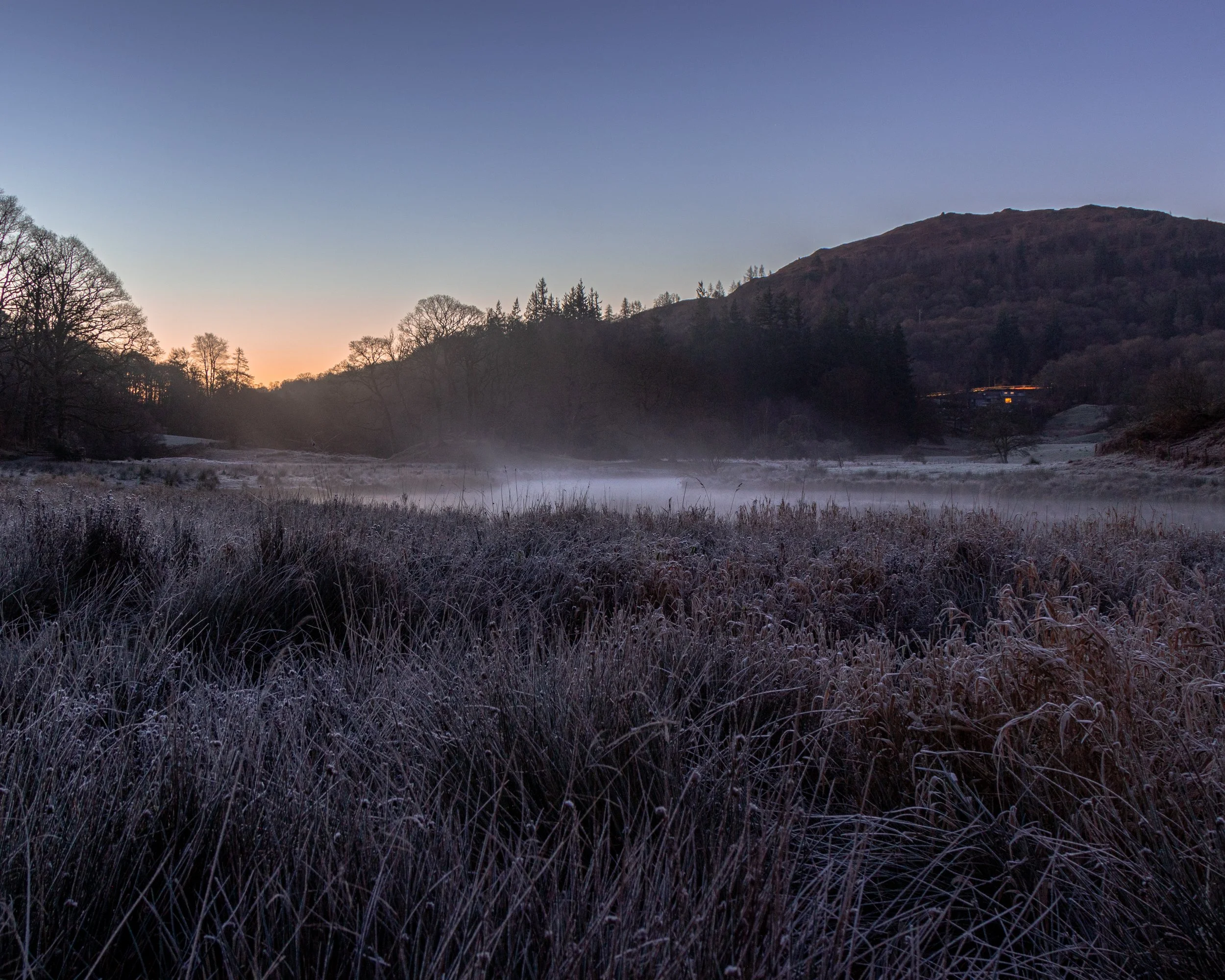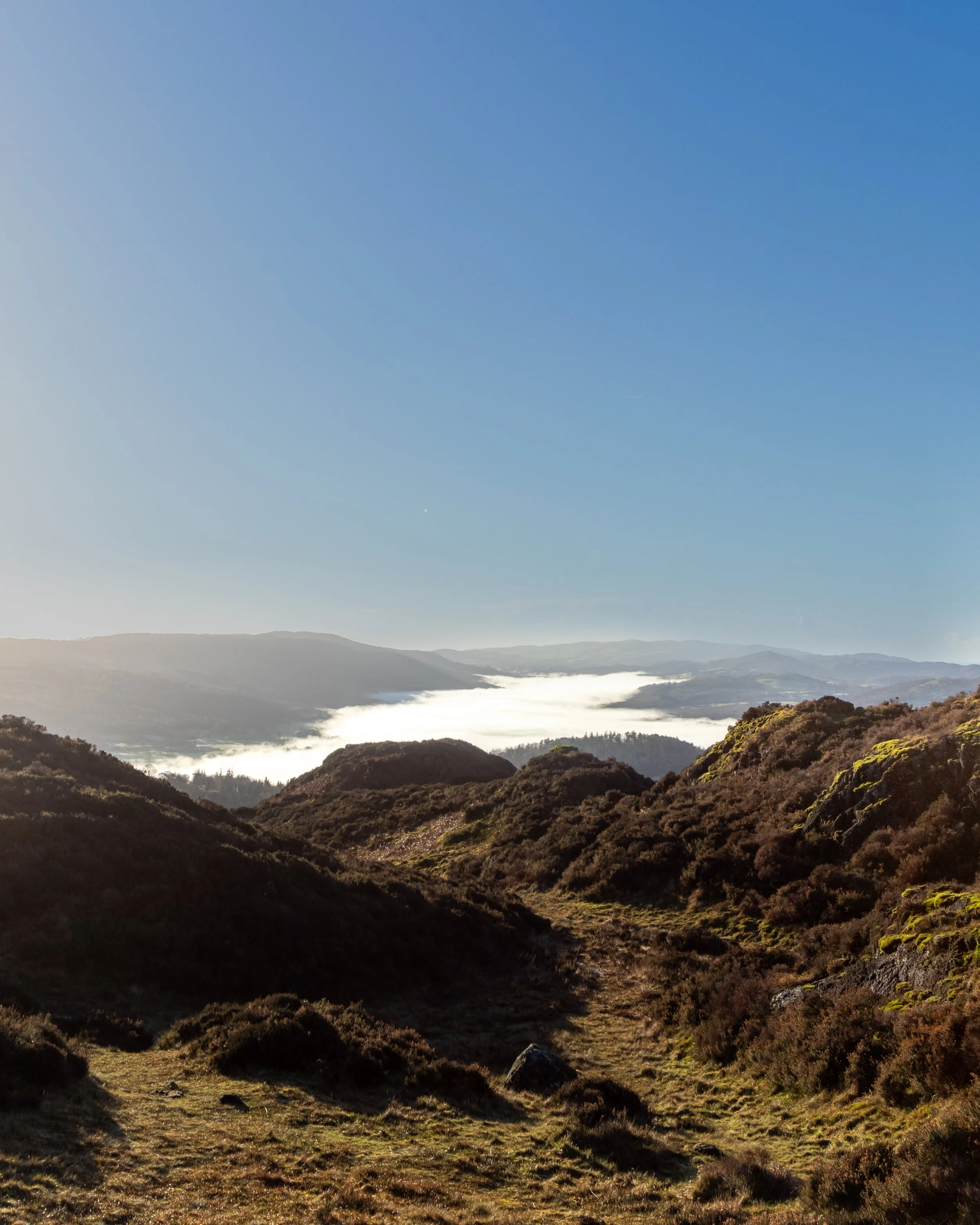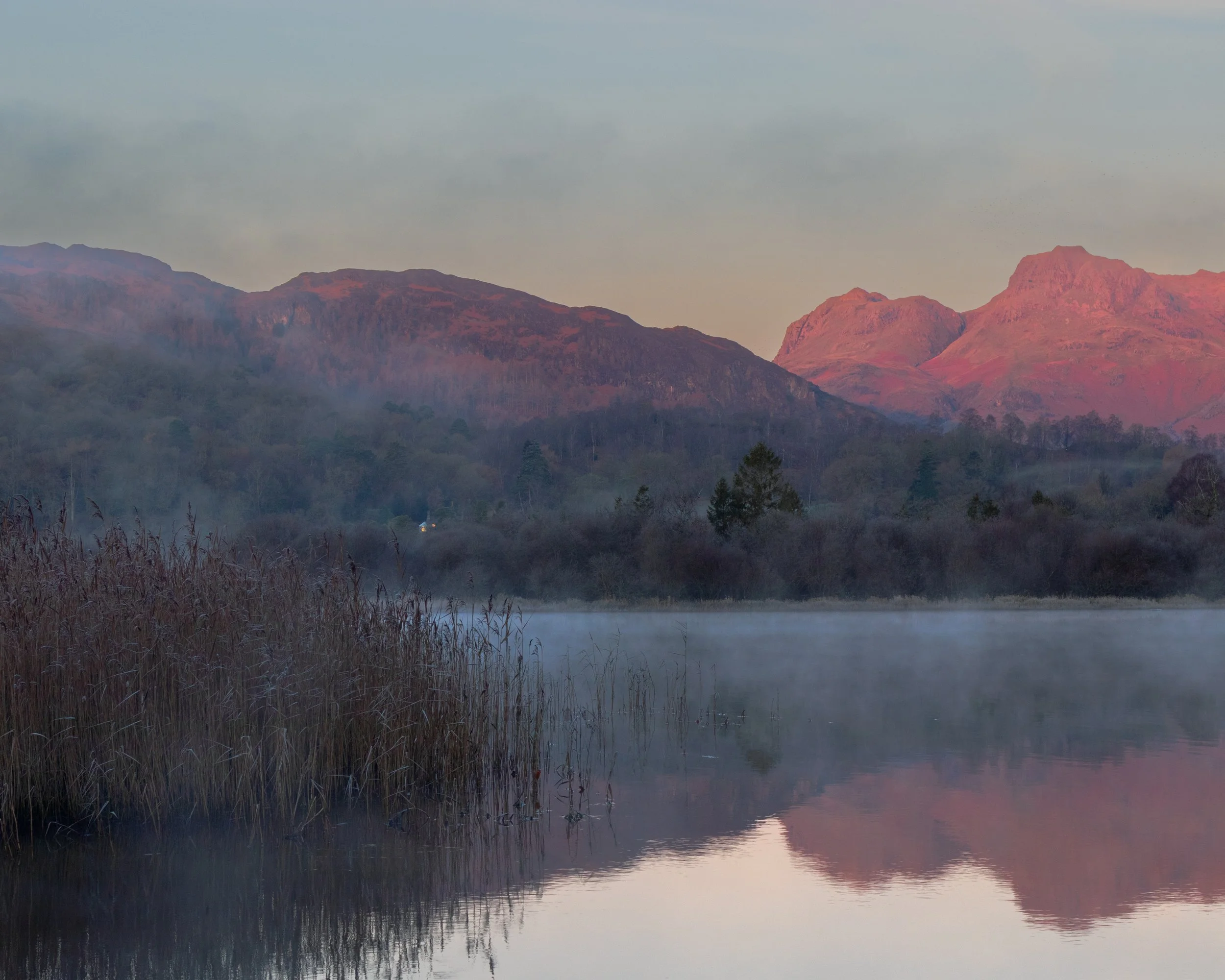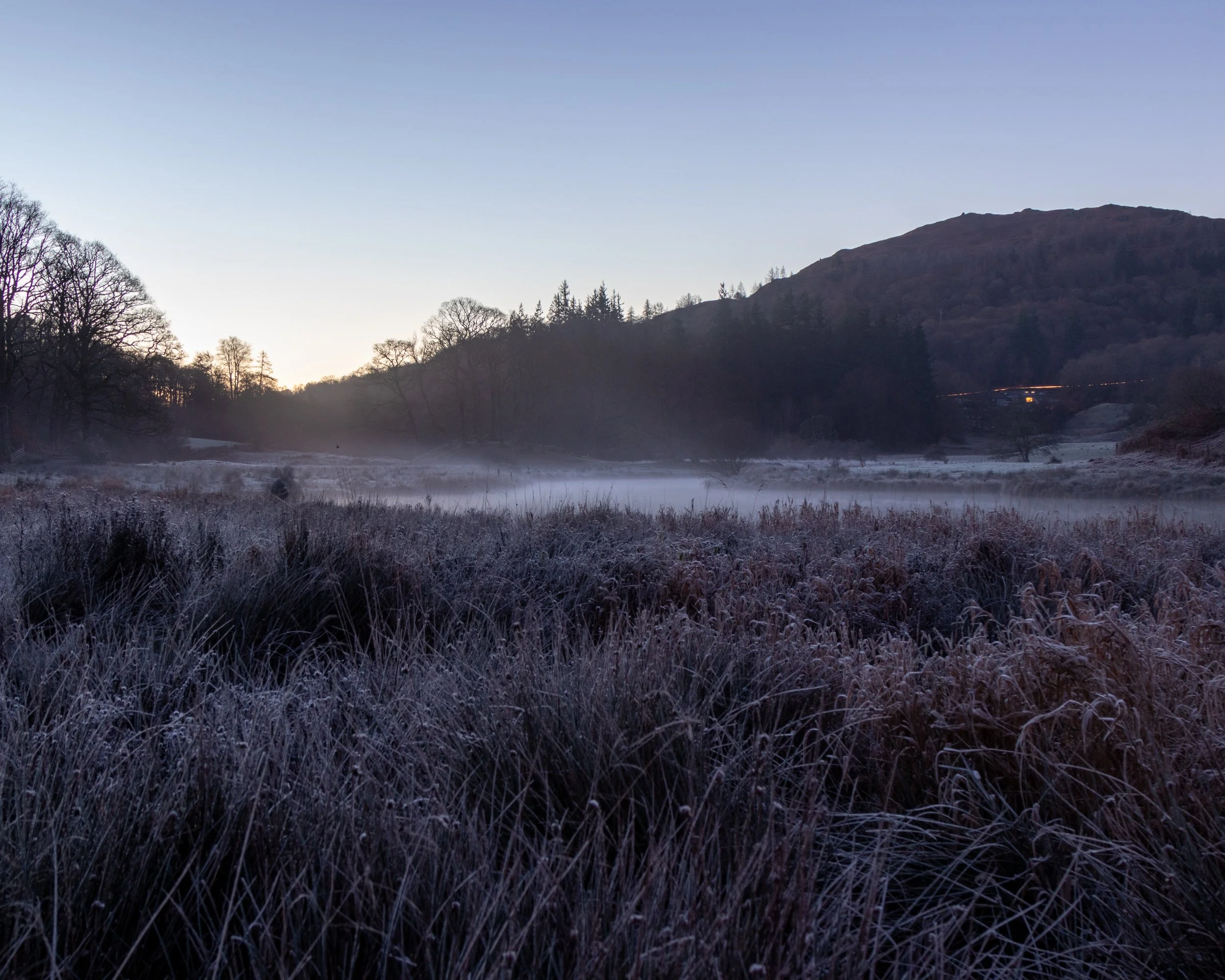Getting Ready for Winter Photography.
As the night’s start to draw in, thoughts start to turn towards the colours of autumn, the cold crisp winter mornings, and lighting the log burner (and getting the slow cooker out of storage!).
I love winter, and as a landscape photographer, I think one of my favourite things about it is sunrise times starting to get later (no more 2am alarm calls for a few months), the sunsets are getting earlier and chances for dark skies and some first forays into astrophotography are getting much closer! (Edit, I wrote this in August and have been out shooting astro and have a high failure rate so far… more to come on this in the future when I have something worth showing and talking about!)
The first thing on my radar will be the amazing autumn colours that we get here in The Lake District. The heathers are now in full bloom and soon the leaves will start to turn to oranges and stunning hues of read. All of which look incredible with some golden hour light, which is now later in the morning. It does mean that the rain is going to be making a comeback (I hope) and that waterproofs are now going to be the order of the day more often than they are not.
1. Yeti Mug.
This is probably an odd choice for number one on this list, but most of us love a warm drink on a cold day and this ensures that I have one waiting for me in the car when I get back!
I love my Yeti mug and for two main reasons - it’s huge (almost a litre) and it stays hot (not just warm), for anything up to about 8 hours. I use this nearly every day for work, and even when I am finishing for the day at around 4pm, after filling it up at 6.30am, it’s still pretty hot.
It’s been a life saver on some of the cold shoots I have been out on previously, even when I have been out only a short walk from the car in temperatures that were so cold my hat bobble froze, I have been thrilled to have this waiting for me in the car to help me warm back up! They are easy to clean and the lid, comes apart completely and is dishwasher safe I got mine from Amazon, have had it for almost 3 years and it’s as good as new.
2. Warm Clothing.
I am not going to fill this section with links to different items, I have a lot of outdoor clothing and listing it here would take forever. Layers are important, especially a good base layer to wick all of the sweat away from your skin to help to keep you warm; start with this and then buy items which will fit over it, that are easy to take off, light enough to carry and small enough to bundle up and stuff into your bag.
I am a fan of wearing hats. During the summer, it’s usually one of my not insignificant collection of UnderArmour baseball caps, and in the winter I opt for something a bit more substantial in the form of my wooly, Rab bobble hat. This covers my ears, is super warm and has kept the heat in on countless, very cold, early winter mornings.
Solid footwear is a must so that you are comfortable, but equally as important (in my opinion) during the winter is a decent pair of gloves. I have these ones, which I got from Amazon for less than a tenner and they have been brilliant. They are warm, have plenty of room and have grips on the palms which are great for holding the camera with. Furthermore, they have fingertips which “pop off” and remain attached to the glove, to expose your fingers so that touchscreen operation is a breeze, as well as allowing you to operate some of the smaller buttons and dials on your camera without getting in a mess because of decreased sense of touch in your fingers. I know you can get gloves which have “touchscreen fingers” and allow you to work touchscreens without having to expose the tips of your fingers, but I have never found that these work well for me and I have settled upon this option instead and so far it’s been a great decision.
Another thing I am going to link in here is some hand warmers, these are a really useful addition to your winter bag. The ones I have linked are the reusable type that you put in boiling water to recycle them. You can get battery powered ones, but in cold conditions the batteries won’t last as long, which is why I prefer these ones. You also can’t forget to recharge these ones, and can’t accidentally take out one which is flat!
Finally… socks! Get some warm socks, spend some money on them and get some good quality ones. I like the Bridgedale ones, they’re comfortable, warm and made of merino which helps to keep your feet warm by keeping any sweat off them at the same time as insulating them!
3. Apps
I won't write a ton about apps here, but will direct your towards my blog Must Have Apps for Photographers, these apps will help you to check sunrise and sunset times, find the part of the world where you need to be for the best shots at these times, plan for the weather and help you to navigate to them.
4. Headtorch
There’s know doubt about it, you are going to need this. You’re often going to be up and about before the sun rises and out until way after it has set. You’re also likely to be traversing some fairly rough, at times unstable, often boggy and sometimes dangerous terrain. The head torch won’t stop you from falling/tripping/similar, but it will give you a bit of an advantage against Mother Nature in the dark. You wouldn’t drive to your location without your vehicle’s lights switched off, so why potentially fall and hurt yourself on the last leg of your trip. I have this one, which is a good balance between price, brightness, battery life and comfort. I’ve mentioned this head torch on this blog before so won’t bang on about it here for too long, but please please please wear ones if you’re in the dark.
5. Acclimatising Your Gear.
This isn’t something you can buy, but it is something that will prolong the life of your gear and could potentially save you money by avoiding expensive repairs or having to replace your gear.
Put simply, your camera and lenses and water are not friends. Going out in the cold to shoot and then coming home all excited to edit your image and unbagging all of your kit is likely to cause condensation both on both your interior and exterior lens elements. Moisture inside lenses is never a good thing so we need to make sure that we do everything to prevent it - moisture will often turn into fungus/mold inside your lenses.
If I know I am going out in the cold, I will leave my bag in a cool room in the house so that it isn’t already warm before I go outside, warm lens + cold air = condensation. Equally, when I get home, I will leave the bag unopened and in the same space in my house to gradually come back up to room temperature in an attempt to prevent any condensation from forming.
So that I am able to edit the images I have taken as soon as I get in, I always remove the card from the camera before I put it away for the final time on my shoot and store the card in a small SD card case which I keep in my bag and then move this to the car when I am travelling home. This way, my gear can slowly warm back up when I get back to the house.
Don’t be tempted to keep your camera under your jacket as you’re moving around on location. This will also cause condensation/mist/fog. Constant cold won’t harm your camera (caveat: unless you’re out in extreme cold or your shooting overnight timelapses in cold conditions, in which case you should probably consider a lens warmer); constant ‘extreme’ changes in temperature which cause moisture, will.
Cold will also affect your battery life. Now obviously, you need to have one in your camera so that it works, but if you are taking a spare, keep it in a pocket close to your body to keep it warm so that you preserve as much charge as possible.
6. Tripod
As landscape photographers, we are often reliant on our tripods. We can spend hundreds of pounds on something which is lightweight and sturdy but they also often come with rubber feet at the bottom of each leg. These feet are great when we have grippy terrain, but if you’re out in the ice and snow then we can accept that there are times when the conditions are a lot slippier underfoot.
You can buy, often quite cheaply, replacement feet for your tripod which have little spikes in the bottom of them, which will you give you some extra stability and help your tripod to both remain stable whilst you shoot and to stay upright if you’re not stood near enough to catch it quickly!
There are spikes and ice claws available for a modest amount on Amazon, and are an ideal addition to your winter photography arsenal.
7. Lens Hoods
Most of us have these with us when we go out anyway, but just because the sun isn’t shining brightly, this doesn't mean you don’t want to try and prevent lens flare in your images. The snow and ice is a huge selective surface often covering much of what we are shooting, and they can both reflect light into your lens no matter where the sun is in the sky and this will cause that unwanted flare in your images, and in snowy/icy conditions, you are really going to notice it - make sure they’re with you and make sure you use them! They’re also pretty handy at keeping the rain off your lens when you’re out shooting in the less favourable weather.
8. Lens Warmer
This is a recent addition for me as I am hoping to get out on the cold clear nights and take some Milky Way photos (so far they have all been cloudy. Sad face.). A lens warmer, which is sometimes called a ‘dew heater’ is a length of neoprene style fabric, with a heating element inside. They usually plug into a battery pack and then wrap around the front part of the barrel of you lens. The point of it is to prevent dew, condensation and mist forming on the front element of your lens when you are out shooting in cold conditions.
You could keep wiping your lens, but this is going to introduce vibration or movement into your camera, which could really make mess of things, even more so than a bit of fog on the front element, so when it’s cold and you’re out for a long time, these are really useful and a great thing to have in your bag.
I have the 30 cm one from Neewer and I’m pretty happy with it.
And Finally…
The Peak Design Camera Capture Clip.
I want my hands free, especially when it’s snowy or icy. I don’t want to break my fall with my hands, but I don’t always want to spend half of time putting by camera in my bag, taking it back out, replacing it… you get the idea. Don’t get me wrong, I am always going to be putting it away if the terrain is getting tricky, but if I’m moving a short distance, or just want my hands free to adjust/move my tripod, or if I want to have a drink, then the camera is going on the clip. I don’t want to be putting it down on cold, frosty and/or slippy ground, for me, it’s safer being attached to me in some way!
So there you have it, this is my list of things that I wouldn’t be without when I am getting ready for a winter shoot. This isn’t a definitive or exhaustive list and it’s certainly not a list that will be for everyone, but for me, these are some of the things I am not leaving the house without.
If you have enjoyed reading this and want more tips, offers and news straight to your inbox then please consider signing up to my mailing list!





